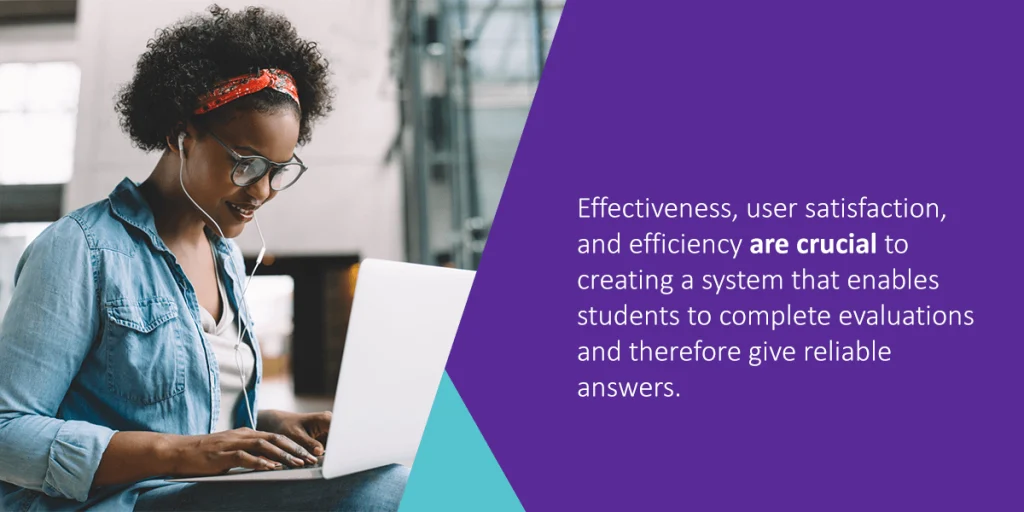



Across higher education departments, feedback is crucial for making decisions like structuring courses and retaining professors. One point of consideration is the reliability of student feedback, as numerous factors can influence this data and its usefulness for decision-making. There are several pros and cons to students evaluating their teachers and programs, and lessening the cons is essential to getting usable data that will help your institution.
Learn more about feedback reliability and how to format your surveys to garner trustworthy data.
Assessment and feedback in higher education help you understand the progress you’re making on reaching a goal for your institution — or set a new goal that you want to strive toward. One essential best practice for student surveys is to have an objective in mind when asking the student body for their thoughts. Once you know how they feel about their classes, professors, and the institution as a whole, how can you make that knowledge work for you?
Knowing how you will leverage this information before launching student surveys lets you use it more efficiently to improve your institution and meaningfully engage with students. For example, end-of-course surveys allow professors to see if they’ve met their teaching goals for that semester through student responses. Using these evaluations, teachers can then adjust their teaching material to better fit student expectations and learning preferences, creating a more valuable educational experience.
Along with goal-setting, student feedback lets you measure intrinsic and extrinsic motivation and enhance rates of student engagement. Different things motivate every student, and some respond better to external rewards and incentives rather than internal motivation.
Other benefits you can see from effective feedback in higher education include:
Student feedback is highly valuable for gauging numerous educational factors, but it’s also worth noting its reliability. Student assessments aren’t completely free from bias, as every person has a level of cognitive bias that subconsciously affects how they think and interact with their world. Conscious bias also plays a role in the reliability of student feedback.
Students may subconsciously or consciously evaluate their professors and their performance based on factors like:
Making significant changes to your educational departments — like choosing who receives tenure — based on these biased results can negatively affect your efforts to improve your institution and cause student and faculty dissatisfaction. Student opinions are important in structuring educational departments, but there must also be a balance between using this feedback and employing other performance evaluation methods to make decisions.
When designing evaluations, consider the impact your own biases can have on student answers. Administrators should be aware of how they frame questions to avoid encouraging specific responses or ignoring certain research in favor of others. Evaluating student answers while expecting certain results can also influence how you interpret and act on the data.

The Likert Scale is a common method higher education institutions use to collect answers on student surveys. It usually consists of five or seven options, including answers ranging from Strongly Disagree to Strongly Agree with Neither in the middle. By rating questions from a range of options, students can give a higher degree of detail when answering, which makes for more accurate data and helps you assess reliability more effectively.
Consider concepts like usability when assessing student feedback. Is your evaluation system easy to navigate and straightforward? Effectiveness, user satisfaction, and efficiency are crucial to creating a system that enables students to complete evaluations and therefore give reliable answers.
In your assessment, you might ask yourself questions about student engagement with your surveys. Are they clearly reading the presented questions? Do they consider their answers before giving them? Getting this type of information can be difficult, especially when asking students to self-assess. That is why one study used eye-tracking technology to see what part of the page students looked at first and how much time they spent reading questions.
Your administration may not invest in this level of technology to research feedback reliability, but it’s still worth considering how you structure your surveys to best engage students. Surveys should be clear to understand, have a logical format, and be comprehensive of your goals without asking too many questions, which could decrease interest and reduce feedback quality.
Before you even get the chance to assess student surveys, think about how you craft and deliver them. To build surveys that can get reliable answers, try these tips:
Keeping surveys anonymous and confidential helps avoid bias from knowing the identity of respondents. Anonymity also gives students more freedom to share their honest insights, facilitating valuable constructive criticism that they might otherwise not share.
Researchers and administrators should remain aware of their own preconceptions and take measures to avoid leading questions that inorganically influence student opinions. Design your questions to follow the evaluation’s purpose and gather insight into your goal while avoiding leading questions that confirm your research or biases.
Open-ended questions allow students to give their opinions freely, and this question format provides more flexibility and detail to complement standard multiple-choice options.
Students should have enough flexibility to provide a range of answers that reflect their experiences. One study showed that 63% of students answered open-ended questions when taking online surveys compared to 10% of students with paper evaluations. Those statistics suggest this digital question format can yield more meaningful feedback.
You’ll need to determine if your course and department evaluations will require questions specific to that field of study in addition to the general course questions that apply across the board. Adding field-specific questions is advisable, as some courses have different learning outcomes, standards, and grading tactics than others — like art or law classes, for example.
Questions should prompt self-reflection in students alongside their evaluation of professors and learning materials. Self-reflection lets learners explore their classroom performance and commitment and see how those factors influence their learning experience. You can then use that self-reflection to inform how reliable an individual student’s feedback is.
Whenever you’re ready to enhance your feedback rates and increase response reliability, turn to Watermark for our digital solutions.
Our Course Evaluations & Surveys platform lets you receive college student evaluations in real time, including streamlined implementation and reporting processes for easier management and integration into your existing systems. Students can access the system wherever they are, and you can customize it to offer different languages and provide reminders and invitations. With these features, you can yield higher feedback rates for more finely tuned insights.
Request a demo of our platform today to start taking advantage of improved institutional research strategies, program goals, and student feedback rates.






























































































































































































































































































































































































